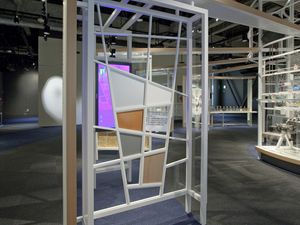Nagoya City Science Museum
TOP > Exhibition Guide > Keyword Search > Starting with "C" > Copper > Heat Conduction / Electrical Conduction
Heat Conduction / Electrical Conduction



Purpose of Exhibition
In the exhibition, "Electrical Conduction", you can compare how electricity is transmitted using many materials. It can be understood what kind of material is easy or hard to conduct electricity with according to the amount of electrical resistance and tone when touching a test rod to each material (The smaller number the material shows, the more it allows electricity through).
In the exhibition, "Heat Conduction" you can compare how heat is transmitted using various materials. Let's see how the heat of a material warmed up with hands is transmitted with images taken by a thermo camera and compare.
Additional Knowledge
[Electrical Conduction]
Generally, metal conducts electricity easily and ceramic and plastic are hard to conduct electricity (* Note). The reason metal conducts electricity easily is because there are free electrons, which can move through the inside of metal freely, as many the number as metal atoms. When voltage is applied to metal, a free electron (electrically negative) threads through metal ions and moves along to the positive pole.
"Silver" conducts electricity the most in all metals. However, since silver is expensive, "copper", which allows electricity through the second most after silver, is often used in electric codes and electric cables. In case of overhead power lines, which are built by passing electric lines over tall steel towers and transmit high pressure electric power, "aluminum" is also used. Compared to copper, the electrical conductivity of aluminum is low, but it is better to bridge towers in long distance with light materials (the density of aluminum is about one third of copper).
In metal, a wire of nichrome (alloy of mainly nickel and chrome) is a hard material to conduct electricity (electrical resistance is high). When electrified into a material with high electrical resistance, heat is generated. For this reason, a nichrome wire is used for electric stoves and toasters.
In this way, various materials can be utilized in the right place by the right person depending on purpose and price.
(*Note: Recently, advanced ceramics with the nature of a semiconductor and plastics that conduct electricity have also been developed.)
[Heat Conduction]
When choosing materials for products, how easy heat is conducted is one of the important factors. As with insulation, a function which does not conduct heat easily, it is highly valued for the purpose of heat retention, There are three heat conducting methods: conduction, convection, and radiation. Heat conduction about objects is described here.
When heating part of an object, the molecule (atom) in that part moves rapidly. It hits molecules (atoms) next to it and makes it vibrate hard. Thus, the motion causes a chain reaction and transmits on and on to adjacent molecules. In this way, conduction (or heat conduction) is the transfer of thermal energy between regions of matter due to a temperature gradient. In metal, heat is also transferred quickly to the area where free electrons are not found in metal. Moreover, this conduction with free electrons is some ten times greater. Therefore, metal is a material that transfers heat easily. In metals, the more easily electricity can be transferred, the more heat energy is carried.
Article by Keiko Ishida, Curator
